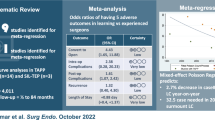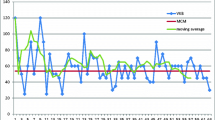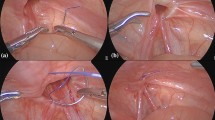Abstract
Purpose
Inguinal hernia repair is one of the most performed procedure all over the world with more than 20 million procedures performed each year. Due to the lack of data in literature about the learning curve of the Lichtenstein procedure, we decided to reproduce a research on learning curves with the same methodology proposed in our previous study about laparoscopic hernia repair. The aim of this multicentre study was to analyse how many cases are required to achieve the learning curve for a Lichtenstein procedure.
Methods
We performed a retrospective analysis of the first 100 Lichtenstein procedures performed by 4 trainees from three different institutions and compared them with the same number of procedures performed by 3 senior surgeons from the same institutions. The data about the achieving of learning curve were evaluated with CUSUM and KPSS test.
Results
No differences about biometrical features were found between the seven groups of patients. CUSUM analysis showed that the trainees achieve the learning curve after 37–42 procedures, reaching an operative time similar to that one of the senior surgeons.
Conclusions
In conclusion, we have shown that the number of procedures required to reach the learning curve from the beginning of surgical residency is around 40 hernia repairs. This number, produced in a controlled environment under strict supervision, could be the minimum requirement to start the procedure of accreditation and specialization in hernia surgery and is higher and steeper than previously reported.



Similar content being viewed by others
References
Bracale U, Sciuto A, Andreuccetti J, Merola G, Pecchia L, Melillo P, Pignata G (2017) Laparoscopic recurrent inguinal hernia repair during the learning curve: it can be done? Ann Ital Chir 88:62–66
Suguita FY, Essu FF, Oliveira LT, Iuamoto LR, Kato JM, Torsani MB, Franco AS, Meyer A, Andraus W (2017) Learning curve takes 65 repetitions of totally extraperitoneal laparoscopy on inguinal hernias for reduction of operating time and complications. Surg Endosc 31:3939–3945. https://doi.org/10.1007/s00464-017-5426-z
Stabilini C, Cavallaro G, Bocchi P, Campanelli G, Carlucci M, Ceci F, Crovella F, Cuccurullo D, Fei L, Gianetta E, Gossetti F, Greco DP, Iorio O, Ipponi P, Marioni A, Merola G, Negro P, Palombo D, Bracale U (2018) Defining the characteristics of certified hernia centers in Italy: the Italian society of hernia and abdominal wall surgery workgroup consensus on systematic reviews of the best available evidences. Int J Surg 54:222–235. https://doi.org/10.1016/j.ijsu.2018.04.052
Brown C, Abdelrahman T, Patel N, Thomas C, Pollitt MJ, Lewis WG (2017) Operative learning curve trajectory in a cohort of surgical trainees. Br J Surg 104:1405–1411. https://doi.org/10.1002/bjs.10584
Tocchi A, Liotta G, Mazzoni G, Lepre L, Costa G, Maggiolini F, Miccini M (1998) Learning curve for "tension-free" reparation of inguinal hernia. G Chir 19:199–203
Simons MP, Aufenacker T, Bay-Nielsen M, Bouillot JL, Campanelli G, Conze J, de Lange D, Fortelny R, Heikkinen T, Kingsnorth A, Kukleta J, Morales-Conde S, Nordin P, Schumpelick V, Smedberg S, Smietanski M, Weber G, Miserez M (2009) European Hernia Society guidelines on the treatment of inguinal hernia in adult patients. Hernia 13:343–403. https://doi.org/10.1007/s10029-009-0529-7
Bracale U, Merola G, Sciuto A, Cavallaro G, Andreuccetti J, Pignata G (2018) Achieving the learning curve in laparoscopic inguinal hernia repair by Tapp: a quality improvement study. J Invest Surg 1:1–8. https://doi.org/10.1080/08941939.2018.1468944
Miserez M, Alexandre JH, Campanelli G, Corcione F, Cuccurullo D, Pascual MH, Hoeferlin A, Kingsnorth AN, Mandala V, Palot JP, Schumpelick V, Simmermacher RK, Stoppa R, Flament JB (2007) The European hernia society groin hernia classification: simple and easy to remember. Hernia 11:113–116. https://doi.org/10.1007/s10029-007-0198-3
Aufenacker TJ, van Geldere D, van Mesdag T, Bossers AN, Dekker B, Scheijde E, van Nieuwenhuizen R, Hiemstra E, Maduro JH, Juttmann JW, Hofstede D, van Der Linden CT, Gouma DJ, Simons MP (2004) The role of antibiotic prophylaxis in prevention of wound infection after Lichtenstein open mesh repair of primary inguinal hernia: a multicenter double-blind randomized controlled trial. Ann Surg 240:955–960. https://doi.org/10.1097/01.sla.0000145926.74300.42(discussion 960-1)
Alfieri S, Amid PK, Campanelli G, Izard G, Kehlet H, Wijsmuller AR, Di Miceli D, Doglietto GB (2011) International guidelines for prevention and management of post-operative chronic pain following inguinal hernia surgery. Hernia 15:239–249. https://doi.org/10.1007/s10029-011-0798-9
Morales-Conde S (2012) A new classification for seroma after laparoscopic ventral hernia repair. Hernia 16:261–267. https://doi.org/10.1007/s10029-012-0911-8
Miserez M, Peeters E, Aufenacker T, Bouillot JL, Campanelli G, Conze J, Fortelny R, Heikkinen T, Jorgensen LN, Kukleta J, Morales-Conde S, Nordin P, Schumpelick V, Smedberg S, Smietanski M, Weber G, Simons MP (2014) Update with level 1 studies of the European Hernia Society guidelines on the treatment of inguinal hernia in adult patients. Hernia 18:151–163. https://doi.org/10.1007/s10029-014-1236-6
Bracale U, Rovani M, Picardo A, Merola G, Pignata G, Sodo M, Di Salvo E, Ratto EL, Noceti A, Melillo P, Pecchia L (2014) Beneficial effects of fibrin glue (Quixil) versus Lichtenstein conventional technique in inguinal hernia repair: a randomized clinical trial. Hernia 18:185–192. https://doi.org/10.1007/s10029-012-1020-4
Negro P, Basile F, Brescia A, Buonanno GM, Campanelli G, Canonico S, Cavalli M, Corrado G, Coscarella G, Di Lorenzo N, Falletto E, Fei L, Francucci M, Fronticelli Baldelli C, Gaspari AL, Gianetta E, Marvaso A, Palumbo P, Pellegrino N, Piazzai R, Salvi PF, Stabilini C, Zanghi G (2011) Open tension-free Lichtenstein repair of inguinal hernia: use of fibrin glue versus sutures for mesh fixation. Hernia 15:7–14. https://doi.org/10.1007/s10029-010-0706-8
Sodo M, Bracale U, Argentino G, Merola G, Russo R, Sannino G, Strazzullo T, Russo D (2016) Simultaneous abdominal wall defect repair and Tenckhoff catheter placement in candidates for peritoneal dialysis. J Nephrol 29:699–702. https://doi.org/10.1007/s40620-015-0251-8
Lichtenstein IL, Shulman AG (1986) Ambulatory outpatient hernia surgery including a new concept, introducing tension-free repair. Int Surg 71:1–4
Robson AJ, Wallace CG, Sharma AK, Nixon SJ, Paterson-Brown S (2004) Effects of training and supervision on recurrence rate after inguinal hernia repair. Br J Surg 91:774–777. https://doi.org/10.1002/bjs.4540
Aquina CT, Probst CP, Kelly KN, Iannuzzi JC, Noyes K, Fleming FJ, Monson JR (2015) The pitfalls of inguinal herniorrhaphy: surgeon volume matters. Surgery 158:736–746. https://doi.org/10.1016/j.surg.2015.03.058
Davies J, Khatib M, Bello F (2013) Open surgical simulation—a review. J Surg Educ 70:618–627. https://doi.org/10.1016/j.jsurg.2013.04.007
Agha RA, Fowler AJ (2015) The role and validity of surgical simulation. Int Surg 100:350–357. https://doi.org/10.9738/intsurg-d-14-00004.1
Sanders AJ, Luursema JM, Warntjes P, Mastboom WJ, Geelkerken RH, Klaase JM, Rodel SG, ten Cate Hoedemaker HO, Kommers PA, Verwey WB, Kunst EE (2006) Validation of open-surgery VR trainer. Stud Health Technol Inform 119:473–476
Khatib M, Hald N, Brenton H, Barakat MF, Sarker SK, Standfield N, Ziprin P, Kneebone R, Bello F (2014) Validation of open inguinal hernia repair simulation model: a randomized controlled educational trial. Am J Surg 208:295–301. https://doi.org/10.1016/j.amjsurg.2013.12.007
Kockerling F, Berger D, Jost JO (2014) What is a certified hernia center? The example of the German Hernia Society and German Society of General and visceral surgery. Front Surg 1:26. https://doi.org/10.3389/fsurg.2014.00026
Kockerling F, Sheen AJ, Berrevoet F, Campanelli G, Cuccurullo D, Fortelny R, Friis-Andersen H, Gillion JF, Gorjanc J, Kopelman D, Lopez-Cano M, Morales-Conde S, Osterberg J, Reinpold W, Simmermacher RKJ, Smietanski M, Weyhe D, Simons MP (2019) Accreditation and certification requirements for hernia centers and surgeons: the ACCESS project. Hernia 23:185–203. https://doi.org/10.1007/s10029-018-1873-2
Author information
Authors and Affiliations
Corresponding author
Ethics declarations
Conflict of interest
All the authors declare that they have no conflict of interest.
Ethical approval
All procedures performed were in accordance with the ethical standards of the institute and regional research committee and with the 1694 Helsinki declaration and its later amendments or comparable ethical standards. Moreover, ethical approval was sought but not deemed necessary by the hospital research committee, due to retrospective nature of the paper.
Human and animal rights
There are no human and animal rights issue to declare.
Informed consent
Due to the retrospective nature of the study a formal consent is not required.
Additional information
Publisher's Note
Springer Nature remains neutral with regard to jurisdictional claims in published maps and institutional affiliations.
Electronic supplementary material
Below is the link to the electronic supplementary material.
Rights and permissions
About this article
Cite this article
Merola, G., Cavallaro, G., Iorio, O. et al. Learning curve in open inguinal hernia repair: a quality improvement multicentre study about Lichtenstein technique. Hernia 24, 651–659 (2020). https://doi.org/10.1007/s10029-019-02064-x
Received:
Accepted:
Published:
Issue Date:
DOI: https://doi.org/10.1007/s10029-019-02064-x




